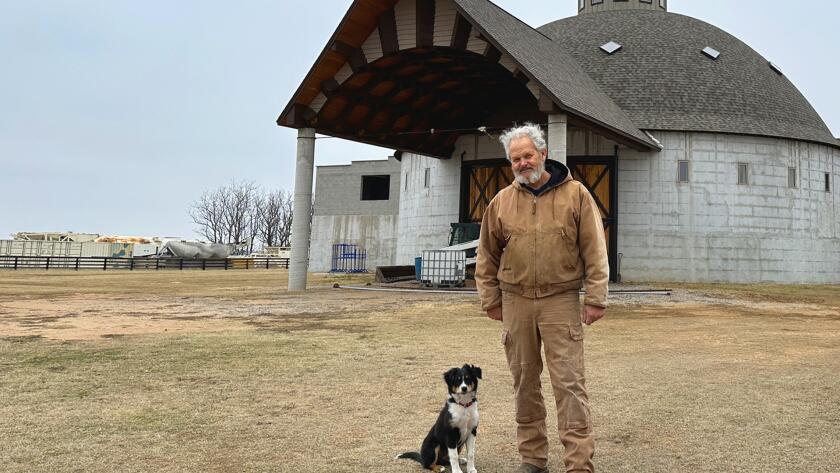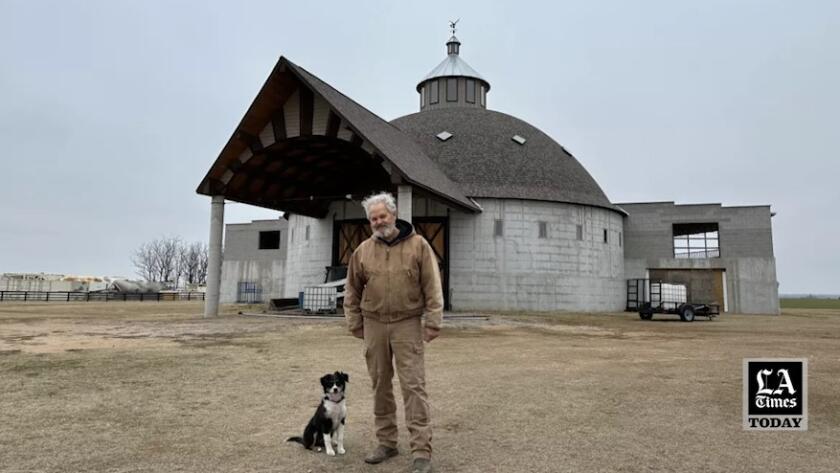A round barn rises in rural America. There is grief and hope in its rafters
- Share via
- Share via
LOGAN COUNTY, Okla. — A curiosity rises amid the wheat fields along rural Highway 33, which cuts through the town of Guthrie.
It’s an immense, circular building — about 15,000 square feet inside — with a domed roof topped by an ornate cupola and a copper eagle. Standing at 72 feet, it is visible for miles on the flat Oklahoma expanse.
Jay Branson is building it in his backyard. He calls it his round barn, but it’s more of a prairie cathedral.
He has been working on it for seven years. As he builds, strangers come. They pull off the highway, haul up his long driveway and stare.
Some, overcome by the beauty, have wept upon seeing the inside of the dome, with its ascending rings of interlocking diamonds and octagons that Jay cut by hand from poplar wood.
At the top is an oculus, a round opening in the roof, like in the Pantheon in Rome. When sunlight streams in, the effect is downright heavenly.
My great-uncle is 59. He’s plain-spoken and self-deprecating, as we Bransons tend to be.
He would never admit it, but he is an artist. Compliment his work, and Jay, ever the stoic, will usually respond: “It is what it is.”
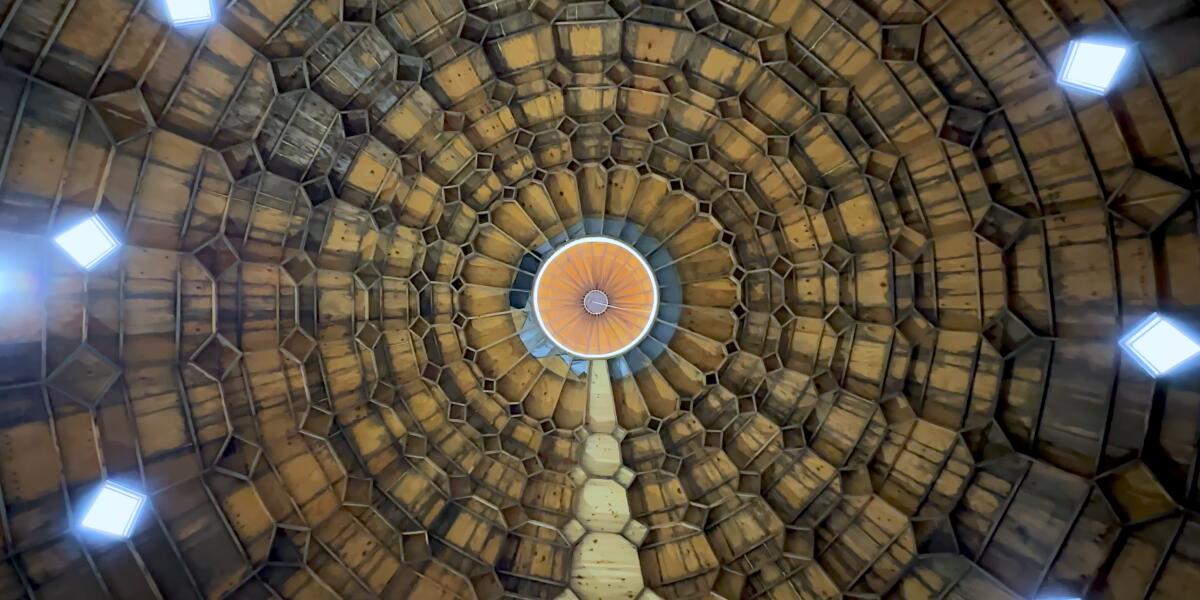
::
As a young man in the 1980s, Jay, a farm boy with a golden tan and muscles chiseled from hay baling and house building, went to Washington to visit a friend.
Inside the U.S. Capitol, Jay craned his neck up, gobsmacked by the dome, wishing he could build one someday.
“There’s nobody in Oklahoma that’s gonna hire my dumb ass to come out and build a round roof,” he remembers thinking. “If you went to the bank to build a round dome, they’d laugh you out of the bank. If it’s not a square box, they don’t want to lend you money.
“I knew my chances of being able to do this would be probably slim to nothing.”
Jay grew up on my great-grandparents’ farm outside the tiny farm town of Marshall, Okla., population 200 or so, where my family — both my dad’s side and my mom’s side — go back generations. In its heyday, it was a proud place nicknamed Prairie City, with a Main Street nearly as wide as a football field — big enough for a team of horses and its legendary high school marching band to make a U-turn.
There’s not much left of the place now. Its only school closed, and its downtown buildings were boarded up long ago.
It’s the epitome of rural Flyover Country, too often dismissed and caricatured by outsiders. But struggling though it may be, there’s beauty — and brilliance — there.
My great-grandparents raised eight kids in Marshall. My grandpa, Jerald “Butch” Branson, was the oldest. Jay, 18 years his junior, was the second youngest.
They were poor. And they worked hard.

At 13, Jay got his first summer construction job, hauling bricks and mixing mortar for a crew building a church parsonage just over the county line. It was backbreaking work, the weather “hotter than blue blazes,” Jay said.
“I’d hauled hay as a kid, but there was no comparison,” he said. “That’s kind of when I decided: You know, I’ve got to either get smart” about what kind of jobs he took on, “or I’m going to be an old man when I’m 20 years old.”
My dad remembers a teenage Jay, mop of curly brown hair and a bone-dry sense of humor, bodybuilding on dirt roads, with a rope harness strapped to his body, pulling an old Jeep like a horse pulling a buggy.
Just out of high school, Jay went to work for his older brother John, who had been doing handyman and remodeling work but wanted to strike out on his own. Using a Reader’s Digest do-it-yourself manual, the Branson boys taught themselves how to frame walls and construct buildings.
Their work was steady, and eventually Jay struck out on his own too. He built houses and businesses and my childhood playhouse, with its own set of monkey bars. He had his own successful construction company and employees.
As he admits, he’s “considered an eccentric,” prone to getting bored with “building a box over and over.”
On a lark, he studied water pH levels and filtration systems and started building waterfalls from native Oklahoma sandstone for homes and a municipal park.
At one point, Jay bought a concession truck, made a custom kitchen for it and started selling cinnamon rolls from a recipe that he ginned up as a teenager, “sitting at home one night in Marshall, that little house, bored off my gourd.”
He called his food truck Sleeping Dog Cinnamon Rolls. It was some of his favorite work, selling desserts at bluegrass and watermelon festivals with his brother John, who battled Parkinson’s disease and was buried last year in his plain white work T-shirt.
But cinnamon rolls didn’t pay the bills. Jay sold the wagon and kept building houses.
“That dang money always gets in your way,” he said. “It is what it is.”
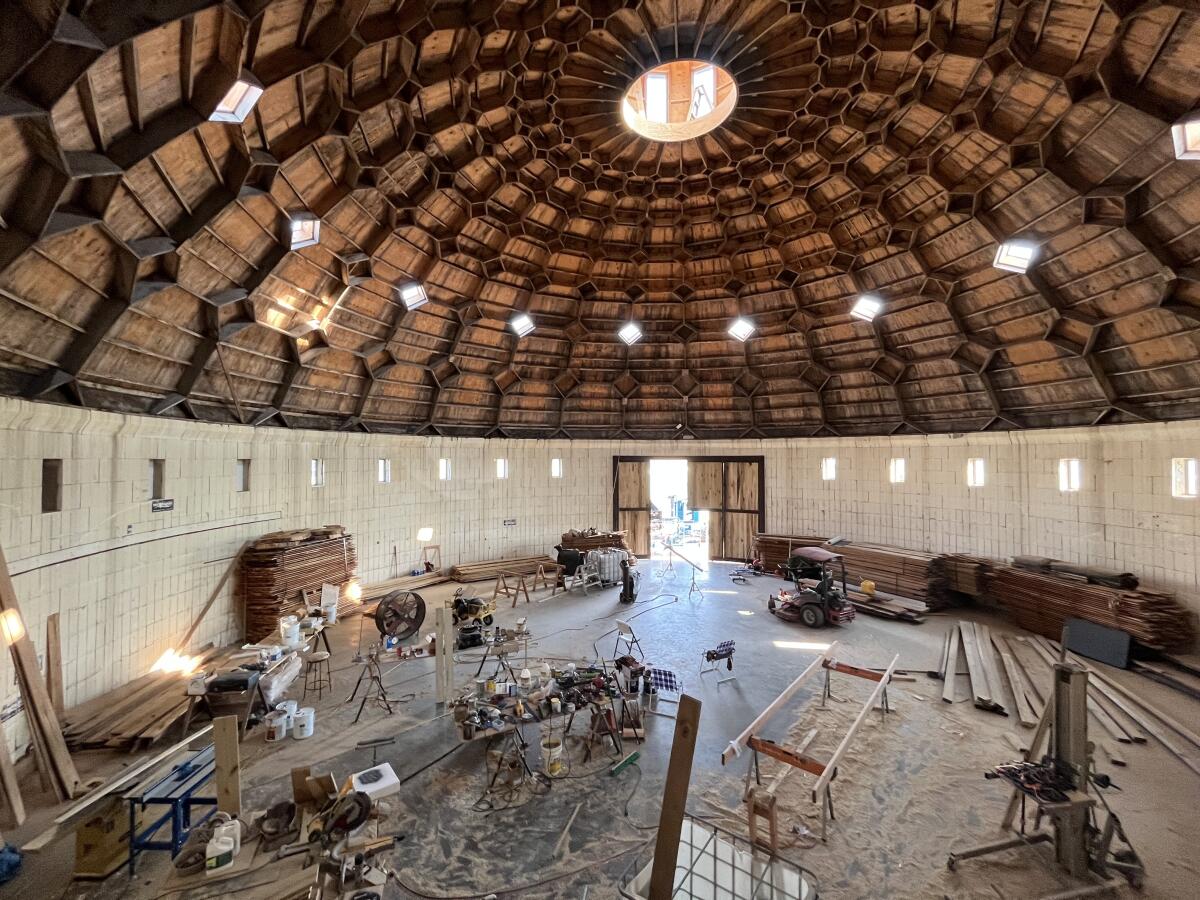
::
Eventually, Jay built himself a squat adobe house a 25-minute drive from Marshall and built a happy life there with his new wife, Julie, her two little girls, and their infant daughter.
Then Julie, a beloved third-grade teacher, started getting sick. She had scleroderma, a cruel autoimmune disease that hardens the skin and internal organs. Jay bought a 45-foot-long motor home that they drove to visit her family out of state. He fixed it up with nice furniture, wanting her to be comfortable.
Julie died in 2016. She was 48.
Her daughters put pictures of her all over the house, smiling with those big brown eyes.
“I’d get up out of the bed that we’d just slept in and go into the closet to get ready for something. There’s her clothes and shoes,” Jay said. “You go in to brush your teeth, and there’s her toothbrush, laying next to yours.”
On the weekends, the girls — the youngest just 10 — would go see friends and try to keep busy. Jay often was home alone with his grief.
To stay sane, he went out to his backyard and started building the barn.
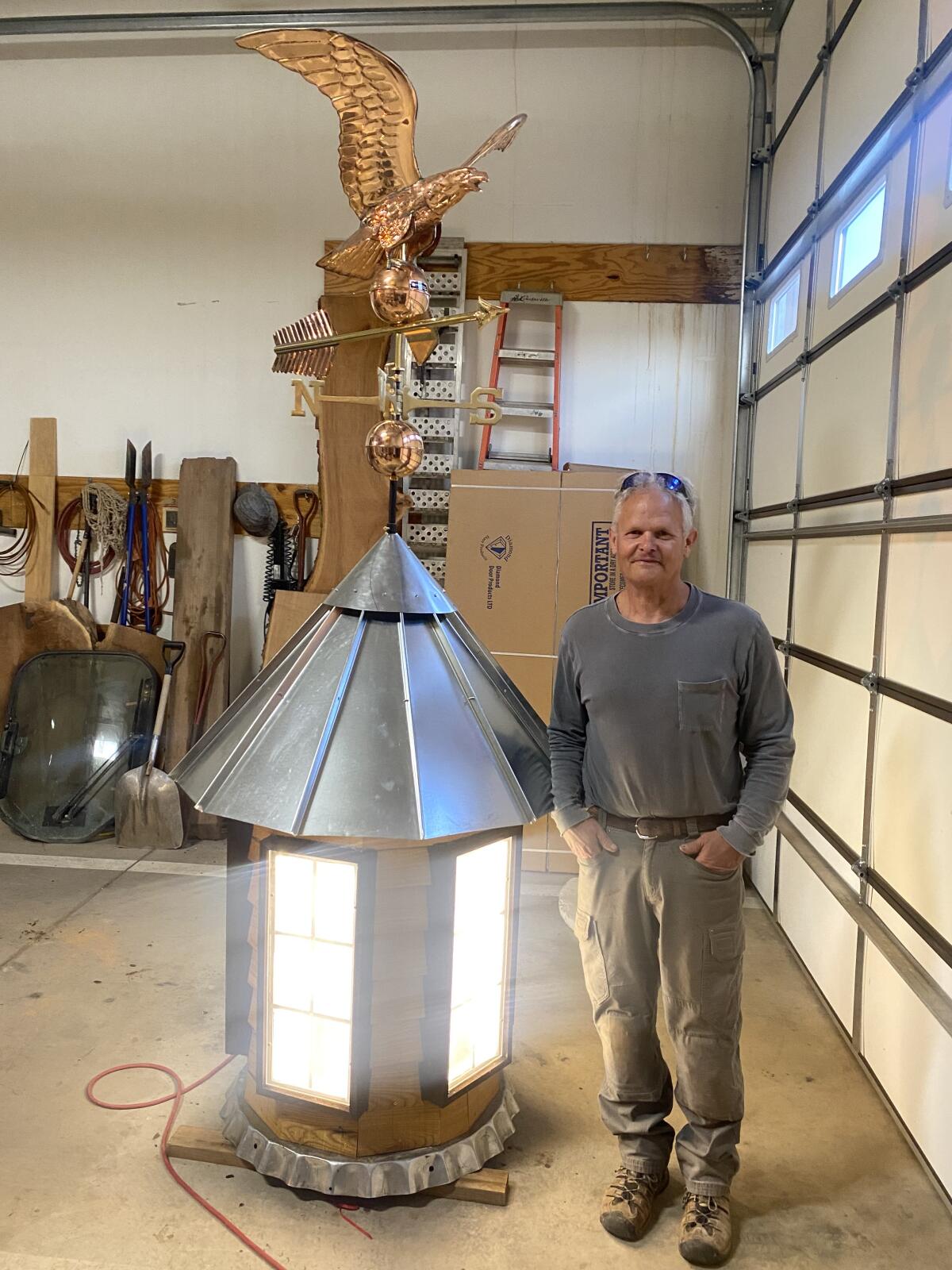
Although not exactly common, round barns have a long history in the U.S.
George Washington had a 16-sided barn at his Mount Vernon estate. And what is said to be the country’s first truly round barn was built by a Shaker religious community in Massachusetts in the 1820s.
They were efficient for farmers who saved time by walking in a continuous circle to feed their animals, said Dennis Craig, a historic preservation officer at the University of Illinois Urbana-Champaign, which has three historic round barns on campus.
Religious folks liked them because, it was said, the devil couldn’t hide in the corners. And round barns were touted as being aerodynamic and more suited to the wind in Tornado Alley than square buildings. The famed Arcadia Round Barn on Route 66, built in 1898, is half an hour southeast of Jay’s home.
Initially, Jay’s was going to be a utilitarian structure, a shop big enough to park his motor home inside and turn it around in. He built it on the weekends and at night, while still building houses.
He began building the walls — using thick, double-insulated foam and rebar blocks that he filled with concrete — in a giant circle.
A neighbor suggested turning it into a wedding venue. He began visualizing a dome, obsessing over it as he lay in bed each night.
Jay drew a simple sketch of the interlocking octagons and diamonds that would form the arched ribs of the dome, but he never made a true blueprint.
“I just started cutting,” he said. “You know, if you figure the circumference of any structure that’s round, and divide it into segments, there’s a way. You’ve just got to make it even, get it exactly right, and just start building.”

Each piece of wood in the dome is hand-cut, uniquely shaped and curved, each placed at a different angle. Using a piece of aluminum, he built himself a tick stick — a centuries-old measuring tool used by shipbuilders for complex wood cuts.
He worked from a manlift that carried him 65 feet up inside. For the top of the structure, he created a steel tower that sat atop the dome and connected a winch line to it. He strapped on a harness and swung from a cable as he worked on the exterior of the structure.
He used poplar that he purchased green and let age for a few years, as well as pine and cherry wood.
For the front awning, he used sassafras, a semi-soft wood that darkens with age, smells like root beer when you cut it, and reminds him of the sassafras tea he drank as a kid.
Jeff Williams, a retired Oklahoma State University architecture professor, said it reminds him of the ancient Duomo in Florence, Italy. The cathedral was under construction for more than 140 years; architects puzzled for years over how to build its dome.
Jeff, whose wife is from Marshall, met Jay a few years ago while standing in line for coffee at a Panera Bread, where they were both regulars.
“At that point, it was just the concrete walls,” Jeff said. “It was interesting to me, just for the use of the materials. But I wasn’t sure whether he was for real or not.
“The more he shared with me, I thought, ‘This is a pretty creative guy.’ But then I started seeing this — and it was like, holy cow.”

Standing in the barn on a frigid day this winter, wind chill in the teens, Jeff told Jay: “This was your therapy.”
A few years ago, Jay got married again. When he met Valerie, whose homemade cookies rival Jay’s cinnamon rolls, the barn’s plain concrete walls were about 3 feet tall. They now stand at 20 feet — taller than the adobe house.
Valerie has helped Jay plaster the walls and prop up pieces of wood taller than herself, gotten him down when he’s gotten stuck on the manlift and dreamed with him about all of the barn’s possibilities.
“She’s been in constant construction since she’s been married to me,” he said.
“I share him,” she said with a laugh. “I share him with that barn out there.”
They envision a grand event space. Jay is building a spacious bridal suite and a bar in an add-on around the back, overlooking a wheat field. Valerie is excited to get going on the interior design, the tile and the colors.
To get all his state permits to make it an event space, Jay had to hire an architect to draw up formal blueprints for the structure — which had already been built without any. He’s nicknamed his barn the Bird’s Nest, since we always called him Jay Bird.
Even as it stands unfinished, so many people have come in off the highway that he finally set out a guest book. The entries are from California, Colorado, South Dakota and Texas. From all over the Sooner State. There’s even one from Canada.
Jay never thought it would take him this long to build the barn.
But five years ago, the prostate cancer that he thought he had beaten years earlier returned. It spread. My strong great-uncle, swinging from the rafters, lost weight. He got tired.
It’s the same kind of cancer that took his oldest brother, my grandpa Butch. A rugged outdoorsman who made teddy bears in his final days, my grandpa died at age 52, when I was 10.
Jay says he’s doing better. He’s trying to get the barn done within the year, and he’s always out working in the heat, the cold and the ever-present wind.
He doesn’t talk about the cancer much.
It is what it is.
- Share via
Watch L.A. Times Today at 7 p.m. on Spectrum News 1 on Channel 1 or live stream on the Spectrum News App. Palos Verdes Peninsula and Orange County viewers can watch on Cox Systems on channel 99.
More to Read
Sign up for Essential California
The most important California stories and recommendations in your inbox every morning.
You may occasionally receive promotional content from the Los Angeles Times.
